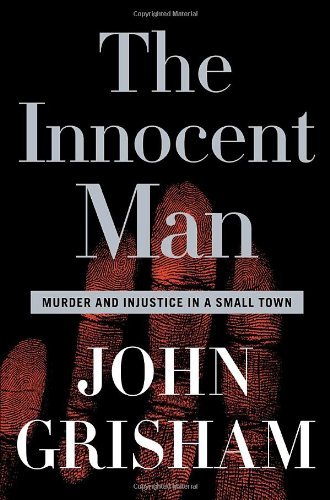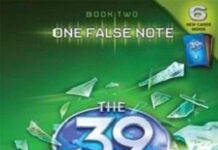In the realm of legal thrillers, John grisham has long established himself as a master weaver of suspense and moral complexity. His foray into true crime with “The Innocent Man” invites readers into a troubling narrative where the line between justice and injustice blurs. This non-fiction work explores the harrowing story of Ron Williamson, a man wrongfully condemned for a crime he did not commit, set against the backdrop of a flawed judicial system. In “Unraveling Truth and Fallacy,” we delve into the layers of Grisham’s investigation, examining not only the chilling details of the case but also the broader implications of how truth can be obscured by error and prejudice. As we navigate this intricate tapestry of fact and fiction, we confront the enduring question: what is the cost of a fallacious justice system, and how does one find redemption in the face of overwhelming adversity? join us as we unravel the threads of Grisham’s compelling narrative, shedding light on the profound injustices that continue to resonate within our legal framework.
Investigation into justice: Exploring Themes of Law and Morality in The Innocent Man

In John Grisham’s The Innocent Man, the intricate relationship between law and morality is laid bare, compelling the reader to confront the gray areas of justice. The narrative follows the true story of Ron Williamson, a man wrongfully accused of murder, illustrating how the judicial system can succumb to human flaws and societal pressures.Central themes emerge, such as the tension between truth and perception, where the rigid structures of law frequently enough fail to align with moral righteousness. Grisham masterfully unveils how a misplaced sense of duty, fueled by sensationalism and false testimonies, strips individuals of their dignity and freedom.This exploration raises crucial questions about accountability in a system that is supposed to uphold justice.
Moreover, Grisham uses relatable characters to deepen the exploration of ethical dilemmas faced within the legal framework. As readers navigate through the procedural missteps, they witness the ripple effects of injustice on personal lives, revealing a stark reality where innocence is overshadowed by flawed investigative methods. Key aspects that underscore this complex interplay include:
- Prejudice: The impact of preconceived notions on legal outcomes.
- Corruption: The influence of power dynamics within law enforcement.
- Redemption: The hope for reclaiming justice and personal integrity.
Through Williamson’s ordeal,Grisham emphasizes the importance of vigilance in the face of institutional inadequacies. The narrative serves not only as a cautionary tale but also as a compelling reminder of the need for continuous reform in a system that often prioritizes expediency over accuracy.
A Deep Dive into Characterization: The Lives Behind the Legal Drama in Grisham’s Narrative

Grisham’s exploration of legal drama transcends mere courtroom battles; it delves into the intricate backgrounds that shape his characters, especially in ‘the Innocent Man’. Here, the lives of individuals entangled in the legal system paint a vivid portrait of hope, despair, and resilience. The narrative unfolds through the lens of characters who each bring their own stories, misunderstandings, and dreams, making them relatable and tragic. From the ambitious yet flawed prosecutor to the steadfast defense attorney,each personality contributes to a multifaceted view of justice and its shortcomings.
In examining these lives, we encounter a tapestry woven with threads of betrayal, ambition, and redemption. the story showcases not just their actions within the courtroom but also the ripple effect their choices create in the community. Key characters include:
| name | Role | Impact |
|---|---|---|
| Ron Williamson | Defendant | Highlighting wrongful conviction |
| John Grisham | Narrative Voice | Chronicling legal failures |
| Judge | Adjudicator | Symbol of flawed justice |
This intricate characterization resonates with readers, serving as a stark reminder that behind every legal case lies a personal story—one that can shatter lives or inspire change.Grisham does not shy away from presenting the complexities of human nature and the legal system, allowing us to witness the profound impact of each character’s journey as they navigate the turbulent waters of truth and fallacy.
The Role of Unreliable Narrators: Distinguishing Truth from deceit in The Innocent Man

In John Grisham’s “the Innocent Man,” the narrative unfolds through a tapestry woven with the threads of unreliable narrators. This literary device is not just a stylistic choice but a critical mechanism that challenges the reader’s perception of truth. Key figures, including legal officials, witnesses, and even the accused, frequently present distorted versions of events influenced by personal biases, societal pressures, or outright deception. As the story progresses, we witness the profound impact of these conflicting accounts, leading us to question the integrity of the justice system itself. with every twist and turn, Grisham compels us to engage actively with the narrative, piecing together facts from fabrications in an attempt to discern the real story behind wrongful accusations.
The notion of truth becomes increasingly elusive as the characters’ motivations come into play. Noteworthy elements influencing the narrative include:
- Personal Bias: Each narrator is shaped by their past experiences, frequently enough clouding their judgment about the events they recount.
- Societal Pressures: the community’s response to crime and scandal further complicates their narratives, as public opinion frequently enough overrides personal morality.
- Legal Dynamics: Attorneys and law enforcement officials wield power over the narrative,using language to manipulate perceptions and outcomes.
Through these unreliable narrations, Grisham invites readers not only to question what is presented as fact but also to reflect on the broader implications of truth in a flawed system—where the reality of one man’s innocence is intertwined with the deceit of those who wield authority.
Pacing and Structure: How Grisham Crafts Suspense in Non-Fiction storytelling

Grisham’s masterful pacing transforms the sometimes dry realm of non-fiction into a gripping narrative. With an eye for detail, he carefully assembles each segment of the story, creating a rhythm that propels the reader through the unfolding drama. This is particularly evident in the way he intersperses personal accounts, forensic evidence, and legal context, building a tension-filled atmosphere that invites readers to invest emotionally in the fate of the characters. Key techniques include:
- Strategic Cliffhangers: Leaving readers questioning the next turn of events.
- Vivid Portraits: Painting relatable profiles of the individuals involved, enhancing empathy.
- Deliberate Reveal: Unfolding critical evidence at measured intervals, maintaining suspense to the last page.
The structure of “The Innocent Man” also mirrors a classic courtroom drama, with Grisham meticulously revealing each layer of the case against Ron Williamson. This technique keeps readers engaged, as they follow the timeline of events through legal battles and personal struggles. An insightful juxtaposition occurs when examining the missteps and victories of both the defense and prosecution, creating a compelling narrative arc. The following table highlights the contrasting elements that heighten the reader’s suspense:
| Element | Impact on Suspense |
|---|---|
| Innocent vs. Guilty | Creates doubt and intrigue. |
| Testimonies | Builds emotional stakes. |
| Evidential Gaps | Increases tension as mysteries unravel. |
Ultimately, the careful orchestration of pacing and structural elements in Grisham’s storytelling fosters a unique blend of factual clarity and emotional intensity, making complex legal arguments accessible and riveting. The interplay between thrilling pace and meticulous detail is what elevates “The Innocent Man” from a simple recounting of events to a profound exploration of justice and its failings.
Impact of Setting: The Importance of Small-Town America in Framing the Narrative
The backdrop of small-town America serves as a character in its own right within grisham’s “The Innocent Man,” intricately weaving the narrative with the fabric of its societal norms and expectations. These towns, frequently enough portrayed as idyllic and peaceful, represent a dichotomy when juxtaposed with the harsh realities of injustice and human fallibility. In such settings, where everyone knows each other, the weight of rumors and perceptions can alter the course of individual lives. The community’s collective mindset absorbs the complexities of criminal cases, frequently enough preferring conviction over the arduous pursuit of truth. This phenomenon is further amplified in the narrative through the portrayal of vigilante justice,where the quest for moral righteousness overshadows empathy and reason,exemplifying how the environment influences the interpretation of justice itself.
Small towns embody a unique blend of close-knit relationships and pervasive scrutiny, enabling a lens through which Grisham critiques both legal and moral systems. As illustrated in the book, local law enforcement and societal figures are not immune to biases, frequently enough reflecting the town’s darker underbelly. The following elements encapsulate the town’s subtle influence on the broader narrative:
- Collective Guilt: Townsfolk may align with wrongful convictions to ease communal shame.
- Cultural Narratives: Local legends can overshadow objective truths, impacting legal proceedings.
- Isolation: The insular nature makes those wronged feel powerless against systemic flaws.
Ethical Dilemmas: Addressing the Gray Areas of Justice and Injustice in The Innocent Man

Grisham’s exploration of a man wrongfully convicted casts light on ethical dilemmas that often accompany the pursuit of justice. The narrative deftly navigates the moral uncertainties that permeate the criminal justice system, serving as a canvas for the juxtaposition of justice and injustice. Within the pages, readers encounter various characters, each embodying the complexities of these dilemmas:
- Lawyers and Ethics: The role of defense attorneys often pushes boundaries, revealing the struggle between winning a case and upholding ethical standards.
- Law enforcement Decisions: Police actions and motivations come under scrutiny, highlighting how personal biases can lead to systemic failures.
- Public Perception: Media portrayal of crime can skew public opinion, creating environments where innocent individuals are vilified.
This account not only interrogates the failures of the legal system but also juxtaposes them against those seeking redemption and truth.the impact of wrongful convictions raises provocative questions about accountability. The interpersonal relationships depicted continue to reveal how personal stakes intertwine with broader societal norms,thus complicating the ideas of right and wrong. As a byproduct, we are led to consider the following ethical questions:
| Question | Implications |
|---|---|
| What constitutes a fair trial? | The balance between justice and defense rights. |
| How should we handle wrongful convictions? | Restorative practices vs. punitive measures. |
| Who holds the system accountable? | The role of law schools and public advocacy. |
Reader Engagement: The Emotional Arc of the Reader’s Journey Through the Narrative

In “The Innocent Man,” Grisham crafts a compelling narrative that takes readers on an emotional roller coaster, deeply engaging them through a diversely layered storytelling approach. As they traverse the journey of Ron Williamson, a wrongfully convicted man, readers are subjected to a series of emotional escalations that elicit feelings of hope, desperation, and outrage. The choices Grisham makes—switching between moments of harrowing despair and flickers of optimism—serve to amplify the stakes and connect the audience intimately to Williamson’s plight. Each twist in the plot is designed to elicit not just concern but a profound sense of empathy, pulling readers into a visceral experience where they feel the weight of injustice alongside the protagonist.
The unfolding narrative also incorporates various elements that enhance reader connectivity, including vivid character portrayals and thought-provoking moral dilemmas. Grisham navigates the complexities of legal battles and their personal ramifications with finesse, exposing readers to both sides of the judicial system. By weaving in testimonies from various characters, readers experience the multiple layers of truth and fallacy at play, leading them to question their own preconceived notions of justice. As emotions peak and trough throughout the book, audiences are challenged to reflect on the broader implications of wrongful convictions, making the journey not just about Williamson but about society’s moral compass as a whole.
Comparative Analysis: How The Innocent Man Stands Against Grisham’s Fictional Works

When comparing The Innocent Man to John Grisham’s more customary fictional narratives, a striking divergence becomes evident. While his novels often blaze through the realms of legal thrillers, complete with gripping plots and charismatic protagonists, The Innocent Man offers a stark and sobering reality check. It is a chilling dive into the flaws of the justice system rather than a fast-paced adventure; this non-fiction work is steeped in the authenticity of a real-life miscarriage of justice.Readers may find themselves grappling with profound ethical questions, as the book meticulously documents the harrowing journey of Ron Williamson, a man wrongfully convicted and sentenced to death. This shift from fictional heroism to vulnerable human experience provides a different reading engagement altogether, making it a unique entry in Grisham’s oeuvre.
Among the elements that distinguish The Innocent Man from grisham’s fictional works are themes of truth, vulnerability, and the nature of justice. These themes unfold as follows:
- Truth: The book advocates for the persistence of factual truth in the face of a flawed system.
- Vulnerability: It highlights the fragility of individual lives within the complexities of legal proceedings.
- Justice: the narrative questions the definition of justice when corrupted by human error.
In examining both Grisham’s fictitious thrills and the real-world implications of his nonfiction narrative, readers are offered an invaluable opportunity to reflect on the inherent contradictions within the justice system. These factors create a layered reading experience that traverses the boundaries between compelling storytelling and brutally honest societal observations.
Cultural Reflections: The Broader Implications of Wrongful Conviction in American Society
The depths of wrongful conviction in America extend far beyond the prison walls, impacting the very fabric of society. Such cases highlight the fragility of our judicial system and provoke critical discourse around themes like justice, morality, and societal trust. The ramifications are multifold,encompassing not only the lives of the wrongfully accused but also the sentiments of their families and communities,who grapple with shattered trust in legal institutions. Key implications include:
- Erosion of Public Trust: As wrongful convictions come to light, a pervasive skepticism about the integrity of law enforcement and the judicial process emerges.
- Advocacy for Reform: high-profile cases stimulate demands for systemic change, illuminating the need for better legal representation and resources for the innocent.
- Societal Stigmatization: The stigma associated with wrongful convictions not only surrounds the individuals directly affected but also extends to their families, often isolating them from their communities.
In examining the cultural reflections stemming from these injustices, it becomes evident that the narratives encourage a broader awareness and dialogue on civic obligation. They challenge us to confront uncomfortable truths about racial and economic disparities in the justice system. Furthermore,it becomes crucial to acknowledge the essential role of public education in preventing future injustices. A closer look at various statistics reveals a stark reality:
| Category | Statistics |
|---|---|
| Percentage of Wrongful Convictions Due to Misconduct | Approximately 50% |
| Racial Disparities in Wrongful Convictions | over 70% involve people of color |
| Length of Time Served Before Exoneration | average 14 years |
Understanding these factors is imperative in fostering a culture of accountability and responsiveness. As we delve into the unsettling truths presented in grisham’s narrative, we are called to action, urging society to recognize its role in advocating for justice and illuminating the path to a more equitable legal system.
Voice and Style: Examining Grisham’s Unique Approach in non-Fiction vs Fiction

In the Innocent Man, John Grisham’s transition from fiction to non-fiction is marked by a distinct evolution in voice and style. While his fictional works are frequently enough laced with gripping narratives and suspenseful plots, this examination of a real-life wrongful conviction in Oklahoma exposes a more journalistic approach. Here, Grisham’s prose is characterized by a calm, methodical tone that serves to convey the somber reality of a flawed justice system rather than the high-octane thrill found in his legal thrillers. This shift allows readers to engage deeply with the facts and the emotional weight of the individuals involved, transforming the narrative into a poignant exploration of human fallibility and systemic failure.
Grisham maintains his signature eloquence but utilizes it to draw attention to the stark contrast between the heroic ideals of the law and the sordid truths behind the headlines. the structure of his work incorporates a range of narrative techniques, including:
- Vivid character sketches that personalize the statistics.
- Chronological storytelling that builds suspense through real-time progression.
- First-hand accounts that evoke empathy and understanding.
Through this synthesis, Grisham invites readers not only to witness the legal failings but also to reflect on broader societal implications, making The innocent Man a compelling blend of narrative accessibility and documentary realism.His unique voice in non-fiction reflects a commitment to truth-telling made all the more powerful by its authenticity.
Ending with Resolution: The aftermath and Real-Life Outcomes Explored in The Innocent Man

The aftermath of the events detailed in Grisham’s depiction of Ron Williamson’s story reveals a landscape marred by injustice yet marked by resilience. The narrative underscores the profound impact of wrongful convictions not just on the individuals involved but on society at large. Williamson’s resilience in the face of overwhelming odds serves as a powerful reminder of the human spirit’s capacity to endure. After years of fighting, his eventual exoneration brought to light several critical outcomes that continue to resonate today:
- Increased Awareness: The public became more aware of wrongful convictions and their devastating effects.
- Legal Reforms: His case sparked discussions on the need for reforms in the justice system,particularly regarding how evidence is handled.
- Support Systems: Organizations aiding wrongfully convicted individuals gained momentum, providing critical support for others like Williamson.
moreover, the exploration of Williamson’s post-exoneration life exposes the intense emotional and psychological repercussions he endured. transitioning from a man marked by his past to one who advocates for justice, his journey highlights the importance of mental health and support for those wrongfully imprisoned. A brief overview of his struggles and achievements illustrates the profound changes in both his life and the legal landscape:
| Aspect | Before Exoneration | After Exoneration |
|---|---|---|
| Public Perception | Criminal | Advocate |
| Mental Health | Severely Affected | In Recovery |
| Community Impact | Isolated | Engaged Leader |
Author’s Perspective: insight into John Grisham’s Journey as a novelist and Advocate for Justice

John Grisham’s evolution from a practicing attorney to a celebrated novelist reveals a profound commitment to justice that permeates his works. His literary journey is punctuated by a distinctive ability to weave intricate tales that reflect the frequently enough murky intersections of law, morality, and the human experience. Through characters who grapple with legal dilemmas and ethical quandaries, Grisham aims to not only entertain but also provoke thought and discussion, urging readers to reconsider the fabric of justice in society. In particular,his non-fiction,like “The Innocent Man,” showcases his deep empathy for those ensnared by the flaws of the judicial system,portraying real events that underline the devastating impact of wrongful convictions.
In his portrayal of the criminal justice system, Grisham draws upon his own background, which lends authenticity to his narratives.This is evident in two key aspects of his advocacy through writing:
- Exposing Injustice: He unearths grave injustices faced by individuals, using their stories as a mirror to societal flaws.
- Raising Awareness: His novels often serve as a platform to spotlight issues such as wrongful convictions and systemic bias.
This dual role as novelist and advocate not only enhances the richness of his storytelling but also transforms his works into powerful calls for reform. As readers engage with his tales, they are invited to ponder their own beliefs about justice and the importance of fighting for the truth, reinforcing Grisham’s position as a voice for the voiceless.
Concluding Remarks
“The Innocent Man” is a poignant and thought-provoking exploration of the human experience in the shadow of a flawed justice system. Grisham’s meticulous narrative weaves together the complexities of truth, deceit, and the fragile nature of innocence, prompting readers to question the very foundations of legal integrity.As we close the cover on this compelling work, we are left not only with an intricate story deeply rooted in reality but also with a lingering sense of unease about the societal mechanisms that frequently enough blur the lines between justice and injustice. Grisham invites us to engage with these uncomfortable truths, urging reflection long after the final page is turned. “The Innocent Man” is more than just a tale; it is a call to grapple with the fallacies that can ensnare us in our quest for truth.










